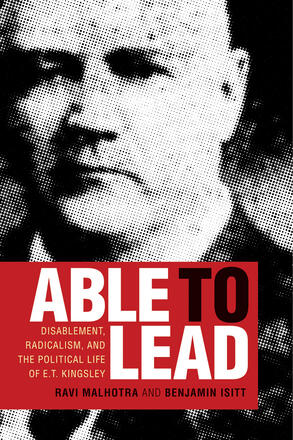
Able to Lead
Disablement, Radicalism, and the Political Life of E.T. Kingsley
Categories: History, Law & Legal Studies, Social Sciences, Disability Studies
Publisher: UBC Press Show Edition Details
Paperback : 9780774865777, 320 pages, December 2021
Ebook (PDF) : 9780774865784, 320 pages, May 2021
Ebook (EPUB) : 9780774865791, 320 pages, May 2021
- Next heading / previous heading, next chapter / previous chapter navigation is enabled.
- Index provides links to item references.
- Single logical reading order.
- Use of colour is not the sole means of graphical distinction or of conveying information.
- A page list enables users to coordinate their reading with a statically paginated version.
- Use of high contrast between text and background color.
- Contains a table of contents that provides direct access to all chapters of the text via links.
Table of contents
Introduction
1 Incident at Spring Gulch: Disablement, Litigation, and the Birth of a Revolutionary
2 California Radical: Fighting for Free Speech and Running for Congress in the Socialist Labor Party
3 Crossing the Line: Eugene Kingsley Arrives in British Columbia
4 No Compromise: Kingsley and the Socialist Party of Canada
5 Kingsley and the State
6 The Twilight Years: Kingsley and the 1920s Canadian Left
Conclusion
Appendix 1: Timeline of the Life and Political Times of E.T. Kingsley
Appendix 2: E.T. Kingsley Election Results
Appendix 3: Partial Record of E.T. Kingsley’s Public Speeches and Lectures
Appendix 4: Obituary for E.T. Kingsley
Notes; Index
Description
Eugene T. Kingsley led an extraordinary life: he was once described as “one of the most dangerous men in Canada.” In 1890, Kingsley was working as a railway brakeman in Montana when an accident left him a double amputee, and politically radicalized. Ravi Malhotra and Benjamin Isitt trace Kingsley’s political journey from soapbox speaker in San Francisco to prominence in the Socialist Party of Canada. They examine Kingsley’s endeavours for justice against the Northern Pacific Railway, and how his life intersected with immigration law and free-speech rights. Able to Lead highlights Kingsley’s profound legacy for the twenty-first-century political left.
Reviews
Able to Lead paints a vivid picture of a fascinating political figure whose oratory one would have liked to have experienced first-hand.
- Giselle Gerolami
...the book provides a rich and lively account of a dynamic period in the history of the Canadian left— and tantalizing glimpses of an extraordinary man who lived in the thick of it.
- John Baglow
...Malhotra and Isitt are to be commended for a book that, besides providing extraordinarily useful information on subjects ranging from the ubiquity of railway accidents in the late nineteenth century to the influence of eugenics on Canadian immigration policies at the same time, recognizes that Kingsley, even though he never spoke or wrote of his disability, likely constantly had to make decisions, whether about the class struggle or where to live, that reflected its existence in an ablist world.
- Neil Dhingra, University of Maryland
Able to Lead... portrays the fractured politics of the B.C. labour left, providing an admiring account of the role of one man in that process… [the book] should achieve its stated goal of encouraging a new perception of the capabilities of disabled people while also prompting a rethink of the early North American left.
- Ron Verzuh, documentary filmmaker
The authors’ focus on this historical figure enriches and widens the lens on BC’s history.
- Janet Nicol